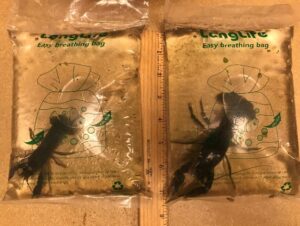This Invasive Species Can Quickly Destroy Aquatic Habitats
An article from WWA’s Words From The Wardens.
This article originally appeared in Wisconsin Waterfowl Association’s April, 2022 eNewsletter.
 By DNR Warden Lt. Robert Stroess, Commercial Fish and Aquatic Species in Trade Enforcement Program
By DNR Warden Lt. Robert Stroess, Commercial Fish and Aquatic Species in Trade Enforcement Program
It’s been about a year since I provided the Wisconsin Waterfowl Association members an overview of the Commercial Fish and Aquatic Species Enforcement Program I manage in our Division of Public Safety and Resource Protection.
I wanted to return to update you on an interesting – and unique – successful investigation involving the self-cloning invasive species known as the marbled crayfish – one of the worst invasive species I’ve encountered.

Marbled crayfish
No Mate Needed To Start A Population
Invasive species show up in all sorts of ways. Some invasives arrive on ships, and some on the boat trailers of outdoor enthusiasts. Sometimes, people purchase invasives as pets without knowing the type of species they are getting.
Eventually, little Susie or Johnny (or their parents) might release their “pet” fish or crayfish into a pond, not thinking about it as an invasive species. The same goes for people who order live red swamp crayfish for their crayfish boils. Before they add the corn cobs, potatoes, seasoning and crayfish to the pot of boiling water, they let the kids play with the crayfish in a front-yard kiddie pool, never thinking that they’re going to escape, but it happens.
Hopefully, it’s just a single critter that gets away in any of these situations. Keep your fingers crossed that the single critter doesn’t lay eggs and find a mate. Chances are it lives out a short life without anyone even noticing it was around.
But, in the case of marbled crayfish, it only takes a single animal to start an entirely new population – no mate required! The ability to clone itself is an astonishingly scary trait of marbled crayfish, allowing it to reproduce at an incredible rate. The species reminds me of the cute little mogwai named Gizmo from the 1980s movie Gremlins. Spill water on it, and it reproduces quickly.
No one understands where this species came from, but it was first identified in Europe in the aquarium trade back in the ‘90s. Because of its reproductive ability and lack of natural predators, the marbled crayfish has taken over as a primary invasive species throughout much of Europe, decimating aquatic habitats and outcompeting native species.
It lives on pretty much any of the native aquatic life it can find in the water – plants, algae, snails and amphibians. It will likely outcompete the native species in Wisconsin’s lake, rivers, ponds and marshes if released. Its presence threatens Wisconsin and other states due to its widespread distribution in the pet industry.
The potential damage the invasive marbled crayfish can impose upon our waters can affect our waterfowl, fish and native plants, which call those waters their home. This is why wardens pursue these cases, hoping to stop the sale, introduction and spread within Wisconsin and states beyond.
Tracking Down The Distributor And Their Illegal Sales
We identified a Green Bay man selling marbled crayfish online in this investigation. It turns out he was raising them in aquariums in his basement, all connected by various hoses and filtration systems. He was taking orders, packaging the cloned crayfish into U.S. Postal Service boxes, and shipping them around the country – to nearly every corner of the lower 48. In total, they ended up in 15 states. The crayfish in his basement ranged in size from one inch to four inches. Wardens seized several hundred of them from the aquariums.
Wisconsin law prohibits possession of all live non-native crayfish species – a proactive rule to minimize the import of illegal, invasive species before they arrive. However, many other states have found themselves behind. They don’t regulate the marbled crayfish because they only list species as invasive after an infestation.
At the end of the investigation, we filed three charges of Transport, Possess or Transfer a Prohibited Species against the 31-year-old Green Bay-based seller. He was found guilty on the three counts in Brown County Circuit Court and paid penalties totaling $885.
AIS Threat Goes Beyond State Borders
It requires teamwork within the DNR and investigators from other states and Canada to fight against these destructive crayfish, including other species beyond the marbled. In this investigation, we sent leads out to the other 14 states, which identified an even larger distributor and the seizure of over 1,000 more of these marbled crayfish.
Visit the St. Lawrence Governors and Premiers Least Wanted Aquatic Invasive Species List to learn more about aquatic invasive species (AIS) threats to the Great Lakes.
I will be back with updates on other interesting cases working through the courts.
Our waters and waterfowl, fisheries and aquatic habitats are too precious to allow any invasive to destroy them.
Remember if you see a potential violation against the environment, wildlife or during an outdoor recreation activity, please report it to our DNR Hotline, 1-800-TIP-WDNR or
1-800-847-9367
